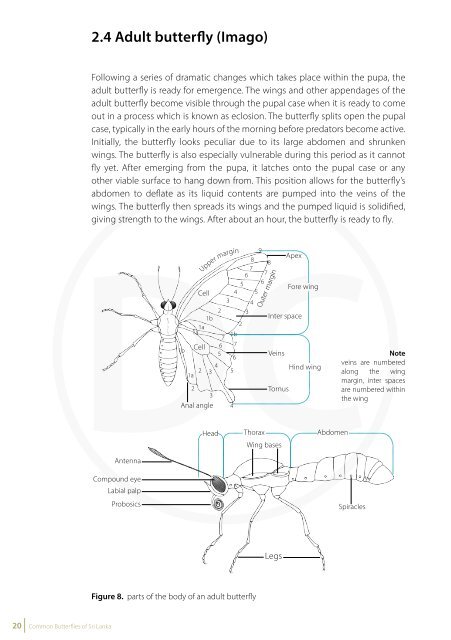Common Butterflies of Sri Lanka
Common Butterflies of Sri Lanka
Common Butterflies of Sri Lanka
Create successful ePaper yourself
Turn your PDF publications into a flip-book with our unique Google optimized e-Paper software.
2.4 Adult butterfly (Imago)<br />
Following a series <strong>of</strong> dramatic changes which takes place within the pupa, the<br />
adult butterfly is ready for emergence. The wings and other appendages <strong>of</strong> the<br />
adult butterfly become visible through the pupal case when it is ready to come<br />
out in a process which is known as eclosion. The butterfly splits open the pupal<br />
case, typically in the early hours <strong>of</strong> the morning before predators become active.<br />
Initially, the butterfly looks peculiar due to its large abdomen and shrunken<br />
wings. The butterfly is also especially vulnerable during this period as it cannot<br />
fly yet. After emerging from the pupa, it latches onto the pupal case or any<br />
other viable surface to hang down from. This position allows for the butterfly’s<br />
abdomen to deflate as its liquid contents are pumped into the veins <strong>of</strong> the<br />
wings. The butterfly then spreads its wings and the pumped liquid is solidified,<br />
giving strength to the wings. After about an hour, the butterfly is ready to fly.<br />
8<br />
7<br />
6<br />
9<br />
8<br />
7<br />
Apex<br />
5 6<br />
Cell 4 5<br />
Fore wing<br />
3 4<br />
2 3<br />
1b<br />
Inter space<br />
2<br />
1a<br />
1a<br />
7<br />
1b<br />
1b<br />
Cell 6 7<br />
5<br />
6<br />
Veins<br />
4<br />
2<br />
Hind wing<br />
3 5<br />
1a<br />
2<br />
3<br />
Anal angle<br />
Upper margin<br />
Head<br />
4<br />
Outer margin<br />
Tornus<br />
Thorax<br />
Wing bases<br />
Abdomen<br />
Note<br />
veins are numbered<br />
along the wing<br />
margin, inter spaces<br />
are numbered within<br />
the wing<br />
2.4.1 Food<br />
In its final stage the butterfly mainly seeks to breed and propagate its generation<br />
while prevailing over threats from predators. Energy from food consumed by<br />
the butterfly in its final stage is channeled towards these activities rather than<br />
for physical growth. Their food intake is entirely comprised <strong>of</strong> liquid except for<br />
tiny pollen grains that may have mixed in the nectar. While butterflies are mostly<br />
seen to feed on flower nectar, they also eagerly suck on rotting fruit, tree sap,<br />
dead animals, human sweat, bird droppings and other fecal material.<br />
Even though species have not been observed to exclusively feed on specific<br />
nectar plants, many butterflies do display a food preference. For example,<br />
the <strong>Sri</strong> <strong>Lanka</strong>n Birdwing (Troides darsius) especially favours Mussaenda frondosa<br />
(uqiaiekao) flowers. The selection <strong>of</strong> species <strong>of</strong> flowers by butterflies depends on<br />
various parameters such as flying height, feeding behavior, the length <strong>of</strong> the<br />
proboscis <strong>of</strong> the butterfly and various differences in flowers such as the length<br />
<strong>of</strong> the corolla tube, alignment and the period <strong>of</strong> anthesis (the time for which the<br />
flower is in full bloom). <strong>Butterflies</strong> also show another feeding habit dubbed mud<br />
puddling whereby they suck on wet soil to obtain minerals. While this habit is<br />
largely restricted to males, some females that belong to species which are long<br />
distance fliers also mud puddle (e.g. <strong>Sri</strong> <strong>Lanka</strong>n Lesser Albatross Appias galene).<br />
2.4.2 Protective Mechanisms<br />
Even though they are sometimes brilliantly coloured, butterflies use camouflage<br />
techniques to a great extent to protect themselves against predators (e.g. <strong>Sri</strong><br />
<strong>Lanka</strong>n Blue Oakleaf Kallima philarchus). ‘Eye spots’ (Ocelli) which feature on the<br />
wings <strong>of</strong> butterflies also complement their survival in two ways. Many Nymphalid<br />
butterflies use these ‘eye spots’ to threaten predators, for these create the illusion<br />
<strong>of</strong> a large predator’s face.<br />
Antenna<br />
Compound eye<br />
Labial palp<br />
Probosics<br />
Figure 8. parts <strong>of</strong> the body <strong>of</strong> an adult butterfly<br />
Legs<br />
Spiracles<br />
Secondly, species such as Lycanids use the ‘eye spots’ to deceive predators. This<br />
spot located at the tornus (the posterior corner <strong>of</strong> the hind wing) coupled with<br />
the minute tail that resembles antennae give the misleading impression <strong>of</strong> a<br />
false head, while the butterfly’s real head remains concealed. This false head is<br />
further exaggerated by the rubbing <strong>of</strong> the butterfly’s wings, giving momentum<br />
to the false antennae. Predators attack this false head and if caught the butterfly<br />
is able to fly away leaving a part <strong>of</strong> its wing in the predator’s mouth.<br />
‘Mimicry’ is another method <strong>of</strong> deception used by butterflies for survival. These<br />
species mimic poisonous butterflies in both colouration and habits even though<br />
they are not poisonous in reality (e.g. Mimes (Papilio clytia) mimic Crows and<br />
Tigers). Usually, birds keep away from these butterflies.<br />
20 <strong>Common</strong> <strong>Butterflies</strong> <strong>of</strong> <strong>Sri</strong> <strong>Lanka</strong><br />
<strong>Common</strong> <strong>Butterflies</strong> <strong>of</strong> <strong>Sri</strong> <strong>Lanka</strong> 21















